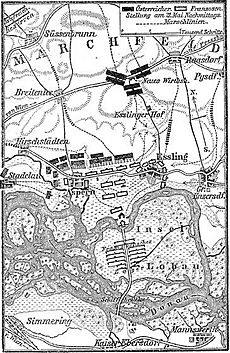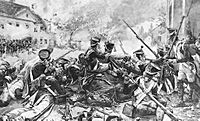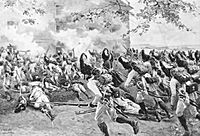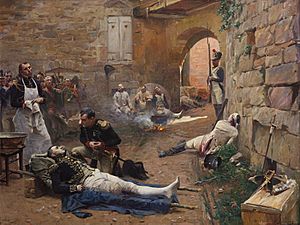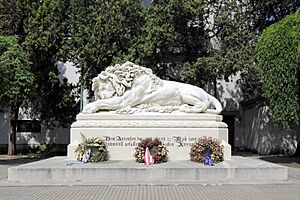Battle of Aspern-Essling facts for kids
Quick facts for kids Battle of Aspern-Essling |
|||||||
|---|---|---|---|---|---|---|---|
| Part of War of the Fifth Coalition | |||||||
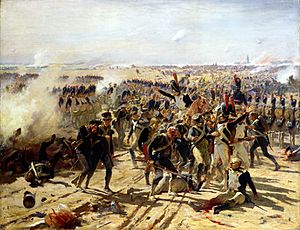 The Battle of Aspern-Essling, May 1809 by Fernand Cormon |
|||||||
|
|||||||
| Belligerents | |||||||
| Commanders and leaders | |||||||
|
|||||||
| Units involved | |||||||
| Hauptarmee | Army of Germany | ||||||
| Strength | |||||||
| 98,260, 292 guns | 80,130, 154 guns | ||||||
| Casualties and losses | |||||||
| 22,900, 2 guns | 19,980, 3 guns | ||||||
The Battle of Aspern-Essling was a major fight that happened on May 21–22, 1809. It took place near Vienna, Austria. During this battle, Napoleon and his French army tried to cross the Danube River. However, the Austrian army, led by Archduke Charles, attacked them.
The Austrians pushed the French back across the river. This battle was very important because it was the first time Napoleon himself was defeated in a major battle. It was also his first loss in 10 years. The Austrians won, but they didn't completely destroy Napoleon's army.
The Austrian army had more cannons and fired many more shots. The French lost over 20,000 soldiers. One of Napoleon's best commanders and friends, Marshal Jean Lannes, was among those who died.
Contents
How the Battle Started
At the time of the battle, Napoleon's army had taken over Vienna. The bridges over the Danube River were broken. Archduke Charles's Austrian army was waiting on the other side of the river. Napoleon wanted his army to cross the Danube.
Choosing a Crossing Point
The French tried to cross the river once before, but they were stopped. They then chose Lobau, a large island in the Danube, as their next crossing point. They worked hard to build bridges to Lobau. By the night of May 19–20, the French had reached the island.
Crossing to the Other Side
By the next evening, many French soldiers were on Lobau. They built the last bridge from Lobau to the river's left bank. General André Masséna's troops quickly crossed and pushed back the Austrian guards. Napoleon brought all his available soldiers to the bridges. By the morning of May 21, about 25,000 French soldiers were on the Marchfeld plain. This plain would be the main battlefield.
Austrian Plans
Archduke Charles did not try to stop the French from crossing. His plan was to let a large enough French force cross. Then, he would attack them before the rest of Napoleon's army could join the fight. Napoleon knew this was a risk. He tried to get as many soldiers as possible to the battlefield quickly.
The French soldiers on the Marchfeld lined up facing north. Their left side was in the village of Aspern (Gross-Aspern). Their right side was in Essling. Both villages were close to the Danube, so the French couldn't be attacked from the sides there. The French had to fill the space between the villages. They also needed to move forward to make room for more troops.
Austrian Attack Plan
The Austrian army was divided into columns. General Johann von Hiller's troops, along with those led by Heinrich Graf von Bellegarde and Prince Friedrich Franz Xaver of Hohenzollern-Hechingen, were to attack Aspern. Prince Franz Seraph of Rosenberg-Orsini's troops would attack Essling. The Austrian cavalry, led by Prince Johann of Liechtenstein, waited in the middle. They were ready to stop any French cavalry attacks.
During May 21, the bridges became less safe because of the strong river current. But French soldiers kept crossing all day and night.
Fighting Begins: Day One
The battle started in Aspern. General Hiller's Austrian troops quickly captured the village. But General Masséna's French soldiers fought back and took it again. The French infantry fought very bravely, surprising even Napoleon.
However, the Austrians also fought with great determination. They surprised the French with their fierce attacks. The three Austrian columns could only capture half of Aspern. Masséna's troops still held the other half when night came.
Cavalry Charges
Most of the French infantry between the two villages were busy fighting on the side. To create a distraction, Napoleon sent his cavalry forward. They charged the Austrian cannons, which were firing heavily on Aspern. The first French cavalry charge failed. But a second charge, with many heavy cuirassiers (soldiers with metal armor), pushed back the Austrian gunners.
The French horsemen rode around the Austrian infantry squares. They also fought against Liechtenstein's cavalry. But they couldn't do much more, and eventually, they returned to their starting positions.
Battle for Essling
Meanwhile, Essling also saw very fierce fighting. French cuirassiers charged the side of Rosenberg's Austrian force. This delayed the Austrian attack on Essling. Inside the village, Marshal Jean Lannes and his division fought hard. They held their ground until night ended the fighting.
Both armies rested for the night. In Aspern, French and Austrian soldiers were very close to each other. Napoleon was not giving up. He worked to bring even more soldiers across the river all night long.
The Second Day of Battle
The battle started again early on May 22. Masséna quickly pushed the Austrians out of Aspern. But at the same time, Rosenberg's troops attacked Essling. Marshal Lannes fought back bravely. With help from another division, he drove Rosenberg out of Essling. In Aspern, Masséna's troops were pushed back by a counter-attack from Hiller and Bellegarde.
Napoleon's Main Attack
Napoleon then launched a big attack on the center of the Austrian line. The entire French center, with Lannes on the left and cavalry ready to support, moved forward. They broke through the Austrian line. French cavalry poured into the gap created between the Austrian forces.
Victory seemed very close. But then, Archduke Charles brought up his last reserve troops. He bravely led his soldiers forward, holding a flag. Lannes's attack was stopped. When his attack failed, the French attack along the whole line lost its power. Aspern was lost again.
Bridges Cut
Then, Napoleon received even worse news. The bridges over the Danube, which had already broken once, were now completely cut. The Austrians had sent heavy barges floating down the river to destroy them.
Napoleon immediately stopped his attack. Essling was then attacked again by Rosenberg's troops. The French fought back and drove them out once more. Rosenberg then focused his efforts on the side of the French center. The French slowly began to retreat towards the broken bridges. This retreat was very costly, but Lannes prevented the French from being pushed into the Danube. Both sides were completely exhausted, and the fighting finally stopped.
After the Battle
The French army lost over 20,000 soldiers. This included Marshal Jean Lannes, one of Napoleon's most skilled commanders and closest friends. He was badly wounded by an Austrian cannonball and later died. Another French general, Louis-Vincent-Joseph Le Blond de Saint-Hilaire, also died from his injuries.
The Austrians suffered similar losses. But they had won a major victory against the French. This was the first time Napoleon had lost a battle in over ten years. The victory showed that the Austrian army had improved a lot. It also showed that Napoleon's army could be defeated.
The French forces pulled back to the island of Lobau. On the night of May 22, the last bridge was fixed. The army waited for more soldiers to arrive on Lobau. The Austrians were surprised by their victory. They didn't take advantage of the situation, which allowed the French to regroup. About a month later, Napoleon tried to cross the Danube again. This led to the Battle of Wagram, where Napoleon won a costly but decisive victory.
A large stone sculpture called the
(Lion of Aspern) stands in front of St. Martin's Church. It is a monument to remember this important battle.
Stories from the Battle
Many people wrote about the Battle of Aspern-Essling. Patrick Rambaud, a French author, wrote a novel called "The Battle". He used many real stories from people who were there. The book describes what fighting was like during Napoleon's time. It also shows famous commanders like Napoleon, Masséna, and Lannes.
Marcellin Marbot, who worked for Marshal Lannes, wrote about the battle in his memories. He described seeing his close friends in their last moments. He also wrote about the great sadness and bloodshed the French army faced after crossing the Danube.
The army doctor Dominique-Jean Larrey also wrote about the battle. He mentioned how he fed the wounded soldiers on Lobau. He gave them a special soup made from horse meat and gunpowder.
Images for kids


